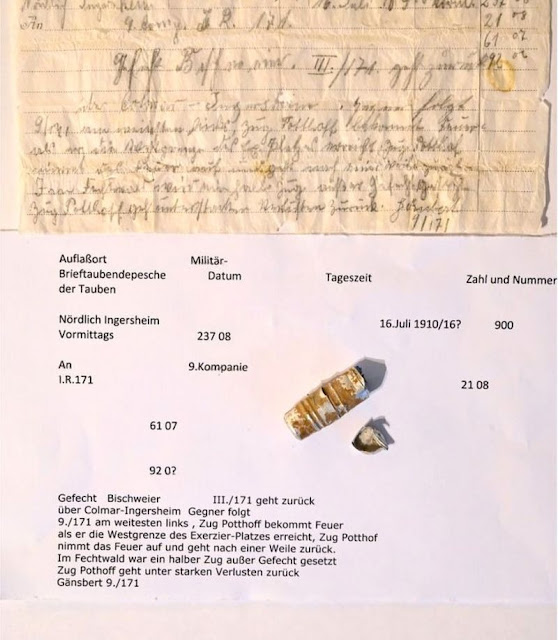 |
| source - The Guardian |
It seems suitably fitting on this Remembrance Day to feature this fascinating article detailing the remarkable discovery of a tiny First World War relic that has defied the ravages of time to be unearthed by chance in a French field a century on.
This is the frankly incredible story of a small metal capsule, as used to send messages by carrier pigeon and no larger than a cigarette end, being found by a couple out walking in the French countryside back in September. Having remained undiscovered for over 100 years it had against all odds survived in the mud of eastern France where it fell until, as with many remnants of the Great War, the movement and turning over of the earth revealed it to some people of today who happened by. The miraculousness doesn't end there, however, for preserved within the miniscule container, which continued to protect it from ten decades of decay, is the original message sent off via carrier pigeon by an unknown German soldier.
 |
| source - B.B.C. News |
That this little slip of paper has managed to survive for so long is nothing short of extraordinary and despite being understandably extremely fragile and barely legible it still offers a fascinating insight into the activities of a small section of the German Army during the era of the Great War. Sent from the town of Ingersheim - at the time part of Germany but now in the Alsace region of France - it details for the benefit of an unnamed staff officer the movements of "Platoon Plotthof", which seemed to be advancing and retreating under heavy fire in an area referred to as "Fechtwald". So faint is some of the writing that unfortunately the precise date cannot be determined, with only the 16th July being clear while the year is still up for debate - either 1910 or 1916. While on the face of it 1916 would seem the more likely - being in the middle of the war when German troops would have been engaged in battle - the curator of the museum to which the couple took their find, M. Jardy from the Linge Museum in nearby Orbey, is inclined more towards the 1910 date. On consideration I can understand why since Ingersheim was within German territory at the time and reference is made in the message to a parade ground, which suggests that it was sent as a part of some military training manoeuvres. Even so that is a striking fact in itself, since it adds to the knowledge that Germany was practising for war years before it finally broke out (and indeed as any student of military history will know, with its Schlieffen Plan Germany had been prepared for another conflict with France for decades - practically since the end of the Franco-Prussian War of 1870, in fact).
 |
| source - B.B.C. News |
This noteworthy find has proved to be a timely yet sombre reminder during this period of remembrance of the build-up to "the war to end all wars" and the sacrifices made in the four years of bloody battles that ensued over one hundred years ago. It also gives one to wonder just what other interesting artefacts are still lying beneath the mud of France waiting to be rediscovered in a similar manner. In the meantime I remain astounded by this particular discovery and delighted that it has found its way to a local museum dedicated to remembering the fallen from both sides in battles both near and far and hope that it can be preserved for the benefit of generations to come.





No comments:
Post a Comment
Don't just sit there, type something! I enjoy reading all friendly and positive comments.